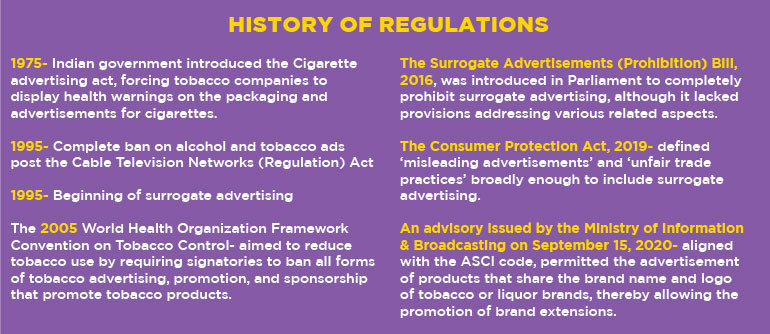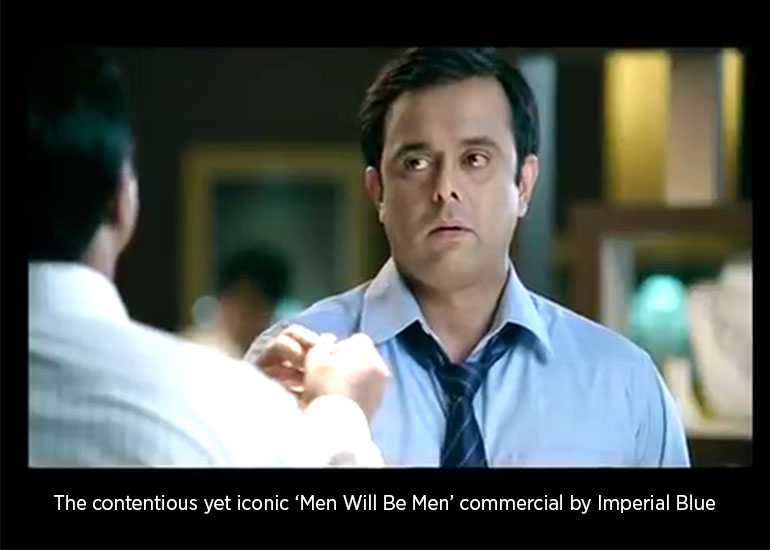On August 5th, a potential regulatory shift sent shockwaves through the alcohol industry, with reports suggesting that the government is considering a ban on surrogate advertising and event sponsorships by these companies. Currently, as direct product endorsements are prohibited, alcohol brands have turned to sponsoring events and promoting legally permissible brand extensions, such as music CDs and mineral water. If this new rule is enacted, it could spell the end for long-standing, high-profile partnerships like Bacardi NH7 Weekender, and campaigns such as ‘Men Will Be Men’. This development raises critical questions about how these companies will be required to adapt their marketing strategies moving forward.
The new regulations will notably require brand extension advertisements to clearly showcase the actual product being promoted, aiming to prevent any potential consumer confusion about the nature of the advertised item, particularly in relation to liquor brands. Additionally, under the existing recommendations of the Advertising Standards Council of India (ASCI), brands should be permitted to advertise these extensions only if the products are available in stores at a volume of at least 10% of the leading product in that category, or if their sales reach `5 crore annually, or `1 crore in the state where they are sold.
The proposed guidelines will notably impact the fast-growing alcohol industry, which as per Statista stood at around 55 billion USD in 2023 in India. In addition to big brands, several smaller players had started entering the space with their unique concoctions and communications. Therefore, when it comes to ad spends in the category, experts note that the proposal can reduce the advertising expenditure by around 30%. Many times, these large-scale surrogate campaigns also feature big celebrities, but the proposed rules will impose certain restrictions and fines on them as well for participating in the making of such endorsements. It will further dent the advertising fraternity.
 Shradha Agarwal, Co-founder and CEO, Grapes, a leading digital-marketing agency, revealed that the revocation of surrogate advertising might have a huge potential to create a dent and severely impact the ad agencies. “Surrogate advertising allows the flexibility of employing superficial branding techniques, which adds to the convenience of the agencies. At the same time, the amount of spending and the number of activities undertaken as surrogate advertising make it a lucrative option for industry. Therefore, the ban can have an adverse effect on the advertising and marketing industry,” she explains.
Shradha Agarwal, Co-founder and CEO, Grapes, a leading digital-marketing agency, revealed that the revocation of surrogate advertising might have a huge potential to create a dent and severely impact the ad agencies. “Surrogate advertising allows the flexibility of employing superficial branding techniques, which adds to the convenience of the agencies. At the same time, the amount of spending and the number of activities undertaken as surrogate advertising make it a lucrative option for industry. Therefore, the ban can have an adverse effect on the advertising and marketing industry,” she explains.
As the awareness increased regarding the problems associated with alcohol and tobacco, the governments of the world and regulatory bodies started getting stricter towards these industries. In India, promotions of alcohol and tobacco were banned after the formulation of the Cable Television Networks (Regulation) Act, 1995, which eventually made way for surrogate advertising and event sponsorships.
While India made many imports from Britain, some because of choice, and many due to the implications of their history; it is quite fascinating that the concept of surrogate advertising found its origin in Britain, from where it then carried on to other regions like India.
When it comes to surrogate advertising around tobacco, they are already prohibited under the Cigarettes and Other Tobacco Products (Prohibition of Advertisement and Regulation of Trade and Commerce, Production, Supply, and Distribution) Act (COTPA), 2003, and the National Tobacco Control Program in 2007. However, surrogate advertisements of alcohol products are still permitted with certain limitations. But then again, the proposed rules can shake things completely.
India is amongst the top 3 alcohol markets in the world, and its recent growth has been immense. Industry professionals note that it cannot be anything other than a ‘must play’ market for everyone, from global conglomerates to home grown entrepreneurs. And boy, have the brands and advertisers been really strong in their creativity game! Hence, along with impacting the growth trajectory of these brands, the move can also bring a halt to creative processes in works. Taking this thought further, Anurag Prasad, Chief Strategy Officer, Lowe Lintas, observes that while implication on revenues would be the foremost consideration, the move can also diminish the potential that the category offers for creative excellence. “Audience’s engagement with the alcohol category is growing not just in terms of consumption, but in much deeper ways, leading to or triggering foundational shifts in culture. For advertising and communication folks that presents extremely fertile grounds for brand and creative thinking,” he adds.
Taking this thought further, Anurag Prasad, Chief Strategy Officer, Lowe Lintas, observes that while implication on revenues would be the foremost consideration, the move can also diminish the potential that the category offers for creative excellence. “Audience’s engagement with the alcohol category is growing not just in terms of consumption, but in much deeper ways, leading to or triggering foundational shifts in culture. For advertising and communication folks that presents extremely fertile grounds for brand and creative thinking,” he adds.

Be it Television commercials or sponsorship of big events, these avenues remain largely untouched by smaller brands primarily due to the costs involved. Which is why many of the smaller and newer brands won’t necessarily get affected by these new set of rules. While direct sponsorships by alcohol brands might be scrapped off, experts note that brands could shift towards the less overt forms of branding. John Royerr, Founder, Ochre Spirits, an alcohol brand from India, shares that for smaller brands, which typically lack the budget for extensive TV ads, this shift is less impactful and may even level the playing field. “Many smaller brands focus on digital marketing and in-store promotions, where they can directly engage with consumers. Furthermore, some brands genuinely sell brand extension products, and their advertisements should accurately reflect this to maintain consumer trust,” he adds.
John Royerr, Founder, Ochre Spirits, an alcohol brand from India, shares that for smaller brands, which typically lack the budget for extensive TV ads, this shift is less impactful and may even level the playing field. “Many smaller brands focus on digital marketing and in-store promotions, where they can directly engage with consumers. Furthermore, some brands genuinely sell brand extension products, and their advertisements should accurately reflect this to maintain consumer trust,” he adds.
It is being said that if these rules come to power, the bigger brands might have to take the same road that the smaller brands take– Digital, plus a lot of below the line promotions, and packaging uplifts. On top of that, experts also mention that this move could prompt brands to use the money they invested on large-scale commercials, on trade discounts instead. However, question still remains on how the new proposal will tackle Digital. Speaking about the approaches that can be taken, Abhinay Bhasin, Senior Vice President, Product and Technology, dentsu shares, “Proposed regulatory change will definitely require a rethink on how brands and their consumers will forge connections in better ways as per guidelines. There is going to be a shift in how content is created and disseminated and how sponsorships work. There is likely to be more efforts in trade and on premise activations guided by regulatory norms. Brands will have to discover novel ways of consumer understanding and conveying their messages.”
Speaking about the approaches that can be taken, Abhinay Bhasin, Senior Vice President, Product and Technology, dentsu shares, “Proposed regulatory change will definitely require a rethink on how brands and their consumers will forge connections in better ways as per guidelines. There is going to be a shift in how content is created and disseminated and how sponsorships work. There is likely to be more efforts in trade and on premise activations guided by regulatory norms. Brands will have to discover novel ways of consumer understanding and conveying their messages.” Talking about what advertisers can do, Yash Kulshrestha, Chief Creative Officer, Atom Network, who has worked on newer alcohol brands like Rascals, shares, “When you limt one avenue of advertising, you open up several new possibilities. A brand might pivot from its core product to create something entirely different. Successful examples include brands leveraging events for revenue, or forming partnerships that extend into lifestyle products, such as limited-edition furniture or accessories. Creative teams must now think outside the box, exploring experiential marketing, strategic partnerships, and bold new ventures.”
Talking about what advertisers can do, Yash Kulshrestha, Chief Creative Officer, Atom Network, who has worked on newer alcohol brands like Rascals, shares, “When you limt one avenue of advertising, you open up several new possibilities. A brand might pivot from its core product to create something entirely different. Successful examples include brands leveraging events for revenue, or forming partnerships that extend into lifestyle products, such as limited-edition furniture or accessories. Creative teams must now think outside the box, exploring experiential marketing, strategic partnerships, and bold new ventures.”
Reportedly, the government and the stakeholders are having talks about the guidelines, and it is yet to be decided if surrogate advertisements by alcohol brands will completely be banned, or if there will be stricter restrictions on brand extensions. Experts acknowledge that the move will definitely have implications, but the ad world will find a way to communicate.

 Manish Bhatt, Founder Director, Scarecrow M&C Saatchi, who has worked on several surrogate ads, highlights that there will always exist a road that will connect the alcohol brands with the customers. “Consumers always seek competition between brands for better choices, regardless of the product’s impact. A brand must create affinity by interacting with the consumer, whether directly or indirectly. Just as lovers in history found ways to communicate, consumers and brands will always find a way to connect,” he states.
Manish Bhatt, Founder Director, Scarecrow M&C Saatchi, who has worked on several surrogate ads, highlights that there will always exist a road that will connect the alcohol brands with the customers. “Consumers always seek competition between brands for better choices, regardless of the product’s impact. A brand must create affinity by interacting with the consumer, whether directly or indirectly. Just as lovers in history found ways to communicate, consumers and brands will always find a way to connect,” he states.
The potential ban on surrogate advertising marks a pivotal moment for the alcohol industry, pushing brands to rethink their marketing strategies. While the shift poses challenges, it also opens new avenues for creative innovation and direct consumer engagement. As the industry adapts to these changes, the resilience and ingenuity of marketers will be tested, ultimately shaping the future of alcohol marketing in India.























